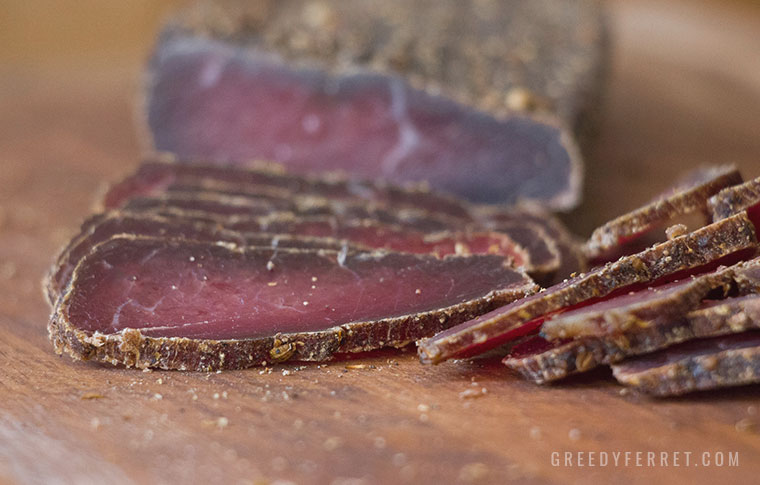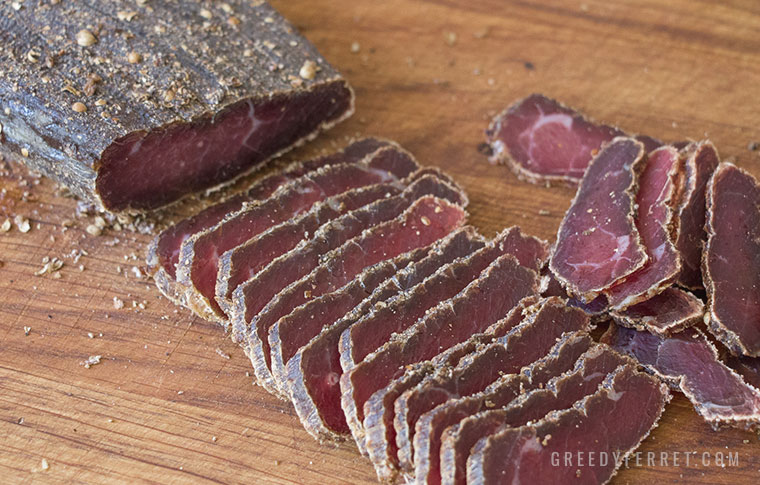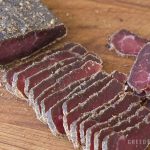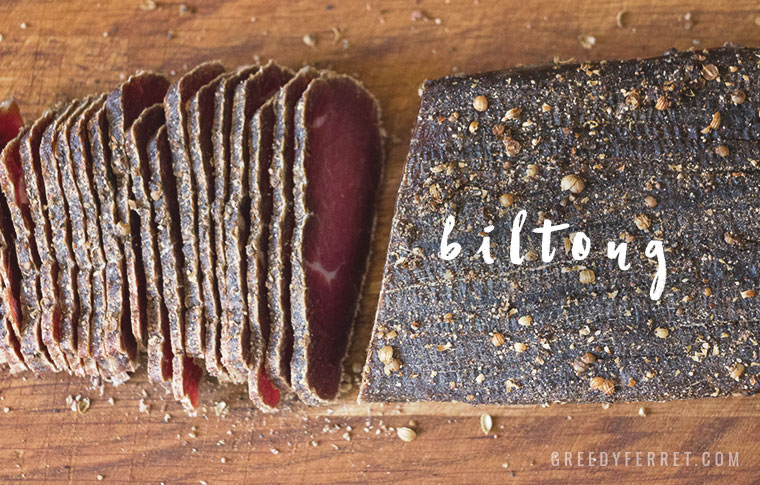I must apologise for calling biltong “South African beef jerky”, because this is a far superior product. If you’ve ever tried biltong, you’ll know exactly what I mean—none of that sugary, rubbery stuff-it-in-a-dehydrator rubbish here, please!
Like a lot of biltong lovers, I was introduced to this culinary treasure as a child, and the addiction has stuck. I’ve been making my own for a few years, gradually tweaking the recipe and feeding it to people with a “how is it, honestly?”, and plenty of willing feedback. I’m confident that this fool-hardy recipe sticks with the traditional roots of the dried meat, whilst adding a little refined finesse—it does not disappoint.
Biltong was originally created by Dutch pioneers in South Africa, “Voortrekkers”, who needed reliable food sources on their long treks across the continent. The method and spice mix hasn’t changed much in hundreds of years, but a few variations have appeared recently, like ‘piri piri’ biltong and the use of additional ingredients like worcestershire sauce and dried chillies.
Curing process
Opinions vary on curing methods, spice mixes and drying conditions, and there is a lot of misinformation around, so trial and error has been my friend. Some recipes call for several stages of curing and washing off spices, reapplying them, etc—this is not necessary. I don’t like to throw away good spices, so I coat once, leave to cure in the fridge, pat dry, then hang with no additional stages. Why wash off and waste all that good flavour? It’s easy to over-salt biltong, making it almost unbearable to eat in bigger quantities (let’s face it, who’s going to only eat a little biltong?), and too much salt can leave a burning sensation, so many recipes call for the salt to be washed off with a water/vinegar solution. My answer? Use less salt! Vinegar does a perfectly good job of sterilising the meat without mountains of salt. The salt is an excellent flavour enhancer and should definitely be included—just a little less to avoid the need for washing.
Temperature and airflow
What we’re trying to achieve when drying biltong is to concentrate the flavour of the beef by removing a lot of the moisture, similar to ‘dry aging’. A combination of good airflow and relatively cool temperatures are the key to successful biltong making. Contrary to popular belief, heat is not required to make biltong—neither does it make for a better product. As a perfect example of this, the Italians make a beautiful beef product called ‘Bresaola’, which is very slowly air dried at cold temperatures, so as to achieve an even dryness and texture. Although heat doesn’t add to the quality of the product, it can be used to increase air circulation around the meat, by means of a temperature gradient (heat rises!). Having said that, don’t be tempted to try and make it in the oven—biltong takes several days to dry, and most ovens won’t go low enough to dry the meat slowly enough to avoid cooking it. What you’re looking for is a slow drying process with gentle airflow. Many DIY biltong makers will use a ‘biltong box’ with a fan and a lightbulb in to create good air circulation. The key is to draw air around the meat without the airflow being too strong, to avoid ‘case hardening’, whereby the outside becomes overly tough, and the texture gradient falls off too quickly.
How to dry biltong
I made my first biltong by hanging it from a piece of wood jammed into a window frame beside a cool window, with a fan on low to circulate air. That’s really all you need to make it. If you want a little more control, you can upgrade to a biltong box or other drying box. I’ve since upgraded to an old fridge with the mechanics removed, holes in the bottom, and a fan drawing air past the meat. The airflow is just enough to draw away moisture, but not too fast so as to avoid over drying the outside of the meat. What you’re looking for is cool conditions with good airflow. Room temperature in most houses is fine, but air flow can be a problem. What you want is a good steady stream of air running past the meat, but not too strong. Try to create these conditions in whatever way you see fit. Just make sure you have a little air flow, or the meat can gather mould—I’m sorry to say this has happened to me in the past! If you want to have complete control over drying conditions, either making or buying a ‘biltong box’ might be the best option for you. You can pick them up pretty cheap online.
Doneness—How long does it take to dry?
I like my biltong a little tough, but still wet in the middle. Some like theirs tough like old leather. Getting it right is down to trial and error. The easiest way to measure dryness is with your fingers. Thoroughly wash and dry your hands, and squeeze the flattest sides of the meat in with your fingers. If there is any give in the meat, there’s still moisture in the middle. Most likely, what you’re looking for is a really tough consistency with just a little bit of give. Leave it too long and you’ll have some tooth-bustingly tough biltong on your hands. That said, it’s fairly forgiving and a day or two over won’t do too much harm.

If you’re impatient and can’t wait for your biltong to dry, plan ahead and cut some thinner pieces to hang with the rest—these will keep you going while you wait for the thicker stuff to be ready. If you’re really savvy, you might vary the thickness of slices from thin to thick allow for consistent grazing over the drying process (highly recommended).
If you find that you’ve cut your biltong early and it’s wetter than you’d like, use clean fingers to rub a little salt and vinegar on the exposed end and hang it back up.
Fat on or fat off?
This comes down to personal preference. It’s important to note that, while your biltong will shrink by around half the size when dried, the fat doesn’t shrink at the same rate as the muscle. I like a little fat because it helps carry flavour, but I tend to remove most of it before hanging. Large chunks of fat can be a little unpleasant to deal with when eating biltong.
Biltong ingredients
Every biltong maker has their own preference on spice mix. If you don’t know what you like, I suggest making a few thinner, quick drying pieces to experiment with. Many home biltong makers add a lot of ingredients to their biltong, thinking that adding more will lead to a better result, but in reality they’re muddying the clarity of the flavour and masking the star of the show—good quality meat!
Vinegar
Traditionally, brown vinegar has been used to make biltong. It really has a recognisable flavour. Some recipes call for balsamic or cider vinegar. I recommend brown vinegar for the best flavour, with cider vinegar coming in a close second. I’ve used cider vinegar a lot, purely because I have a large batch I made at home.
Salt
Salt is a brilliant flavour enhancer and preservative. It kills bacteria on the outside of the meat, and helps to draw moisture out. It’s tricky to get the salt quantity right. My recipe uses the smallest amount of salt required to make a safe cure, based on the weight of the meat. My local butcher goes way overboard with salt on their biltong. I sometimes use them in case of emergency biltong shortage, so I’m not sure how to break it to them…
Coriander
Coriander seed is the signature spice that makes biltong instantly recognisable. It’s best to toast the seeds to release the oils for flavour, but also because the oil suppresses bacterial growth.
Black pepper
Black pepper and beef are a pair made in heaven. Just don’t overdo it—biting into a lump of peppercorn is not a pleasant experience! You want roughly 1/4 pepper to 3/4 coriander seed for a good balance. In most cases, flies aren’t a problem, but pepper has the added benefit of detering them.
Brown sugar
Brown sugar has a caramel and molasses flavour that adds complexity to the meat, without masking it. The sugar helps with drying through osmosis, latching onto the water molecules and ‘wicking’ them away. It’s not a traditional ingredient if we’re going full purist, but it balances the saltiness well. Too much sugar is really unpleasant though—you’re walking dangerously close to beef jerky territory and I’d really recommend against it. Biltong is a savoury snack, not a desert!
Bicarbonate of soda
Some recipes call for the addition of bicarbonate of soda. This might seem a little odd, but it has scientific reasoning. The bicarb neutralises the acid in the vinegar, but also acts as a meat tenderiser. It slows the contraction of the proteins, leaving the final product still dry, but less tough. Bicarb has a pretty unpleasant taste, so it’s important to keep the quantity low. If you’re using a good cut like silverside or toprump, you won’t need it at all.
Cutting methods

If you’ve ever tried cutting over-dried biltong, you’ll know how tough it can be—tough as old boots! In desperation, I’ve taken to resting a knife on top of some over-dried biltong and hitting it with a camping mallet (not recommended, and not only because I upset the neighbours and smashed the chopping board!). There are a lot of creative, almost ceremonial devices on cutting biltong, but I think nothing beats a good, sharp knife. If you want something a little more fancy, there are biltong cutters (a board with a hinged knife attached), biltong knives (traditional knives made for purpose), hand crank mechanical cutters, and at the high end, expensive elecric cutters, mostly used by butchers and biltong suppliers.
Dealing with mould
Check your biltong every day for mould. If conditions are particulary humid or hot, there’s a chance you might experience this problem. If you see the first signs of mould appearing—white dots or furry mould—use a clean cloth with some vinegar and dab/wipe it off. Be sure to get it all or it’s likely to spread again. If you’ve not checked for a while and found your biltong totally covered, sadly the best place for it is the bin. Good airflow will help to avoid such catastrophes in future.
Storing your Biltong
After your biltong has dried to your preferred consistency, you can continue to store it hanging in a well aerated space indefinitely. Shops that sell biltong will often hang it and leave it out, and these are ample storage conditions—just try to make sure none of the pieces are touching. It will continue to dry slowly, but it will also keep for a long time this way. If you’ve cut your biltong and want to store it, wrap it in a few paper bags and store it in the fridge. The paper will allow excess moisture to continue leaving the meat, discouraging mould growth. I can’t give accurate advice on how long to store it this way, but I think it’s safe to say that no sane person is going to leave biltong uneaten for more than a few days. It’s just too delicious!
Case hardening
If there is too much air flow around your biltong, the outside can firm up really quickly, leaving the middle soft. If the case hardening is severe, the tough outer layer can prevent moisture from leaving the middle. If you find that you’ve been testing your biltong for readiness for 2-3 weeks and it just doesn’t seem to be drying in the middle, this may be your problem. If you suspect that case hardening is your problem, I recommend cutting through the end of the meat and checking it. If you’ve got a really raw centre and thick, tough outer surface, give it a try and see if you like the texture. If you don’t, the first option is to vacuum pack the biltong and store it in the fridge for one week to one month, depending on severity. This will balance out the gradient. If you don’t have access to a vacuum sealer, stick your biltong in a paper bag and place it in the fridge for a few days. Rub a little salt on the cut ends to protect them. This should go some way towards fixing the problem. It’s worth noting that the thicker you cut your initial beef cuts, the slower the drying process must be to avoid case hardening, so try cutting thinner next time. However, the best solution to prevent case hardening from occurring is to change your drying setup to reduce air flow. You still need a little air movement, but the slower it dries, the more even the moisture gradient will be from inside to out.
So without further ado, here’s my tried and tested biltong recipe. Once you’ve given it a try, please let me know how you like it, and if there are any variations to the traditional ingredients you swear by, no matter how strange!
Oh, I also added an extra function to the recipe that allows you to change quantities based on meat weight – don’t say I don’t spoil you! 😉

Perfect Biltong Recipe
Ingredients
Meat
- 2000 g Beef—silverside or toprump
Curing spice mix
- 5 Tbsp Brown (malt) or cider vinegar
- 2.5 Tbsp Coarse salt (2% of the meat weight)
- 2 tsp Ground black pepper
- 2 Tbsp Coriander seed
- 1.5 Tbsp Brown sugar (optional)
Instructions
- Toast the coriander seeds in a dry pan, then grind down in a pestle and mortar or spice grinder. It should be mostly powder, with a few pieces of seed shells left in.
- Using a sharp knife, following the grain of the meat, cut into 1 inch (2.5cm) thick lengths and place in a non-metallic container.
- Combine all the spices and sprinkle into the meat. Sprinkle the vinegar on and rub everything in thoroughly whilst turning the meat with your hands.
- Cover the container and let your biltong cure for 24 hours in the fridge, turning and rubbing through the meat occasionally.
- Remove the meat from the container and pat dry with kitchen towels, taking care not to remove too much of the spice.
- Add a hook to the thickest end of each length. Plastic-covered paper clips make for a cheap solution. Hang in your biltong box, or in a well aired, ventilated space with a fan blowing gently to increase air flow. Do not point a fan directly at the meat (to avoid case hardening). Make sure none of the pieces are touching. Place some newspaper below the meat to catch any liquid.
- Drying times will vary with humidity, airflow and temperature. Test the readiness of your biltong every couple of days by squeezing the sides together with clean fingers. If you feel any give in the meat, it’s still ‘wet’ inside.
- Once ready, cut into thin slices with a sharp knife and enjoy some of the best meat you’ll ever eat.


I have a home made wood dehydrator. My set up will dry 10 lbs of jerky meat in 12 hours at 125 degrees. Will this be too much airflow with the heat shut off? vents are 1/2 holes around the bottom with a fan mounted on top drawing air out.
So I slice the meat and allow the spices to be rubbed all over the meat prior to curing? That confused me because all of the examples only show spicing on the outside of the cut.
Hi, I used this marinade- your exact measurements- on approx. 1.5kgs of silverside. I used a little mixed herbs and substituted red wine vinegar. It turned out absolutely perfect! That vinegar really enhanced the flavour! This, coming from someone who never ever uses any sort of vinegar for anything! Oh, I poured the marinade into a zip lock bag, added meat n massaged it in thoroughly. Laid the meat in neat piles and left it in fridge overnight. Turned the bag over in fridge the next day. Hung it up to dry the following day. I made it in one of those flimsy biltong makers from the South African shop, that we get in New Zealand. It took 4-5 days until it was ready to eat. I like it drier. Making more tonight. Thank you, munchly😋
Followed the recipe with half of 1 kg, and added cummin to the rest! Wow, that was really something! We used a dryer with fan, for 2 1/2 half day. Less than 40 degrees. Worked well for us!
your picture shows using a whole piece of meat then sliced up after curing. But
your recipe is calling to slice it up before curing ? is there something different that you do if using whole piece of meat.
I made my first batch – fantastic!
I hung in my oven on “Defrost” setting with the door slightly ajar. This moves room temperature air around the oven. I checked the interior to make sure no direct air onto meat. Worked like a charm and ready in 48 hours.
Your recipe and description inspired me to build the box in the pic and that’s my first batch hanging in there. It’s a solid recipe as I tried my first piece today. May make minor modifications in future recipes, but I like how it’s turning out. Thank you!
Hi greedy ferret!
I put on way too much salt and i have not dried it yet.
What should I do to remove the salt?
please any help ASAP
Hi I’ve made a biltong box does well for around 1kg of meat I mainly use venison.
Storage box with square hole for a usb computer fan on the lid.
Dowel holes drilled evenly down the box and fly mesh netting bottom of the box and where the fan goes to stop u wanted guests.
Takes 3 days to dry my biltong.
Attached is my box very crude but in all cost £20 to build and I’m no diy expert as you can see.
Hi greedy ferret!!
i have no patience to wait a couple of days, so i decided to just place the meat in an oven with only the light oven fan on (with no heat at all)
i also put a big pot in to disperse air flow to avoid case hardening
I found that 36 hrs was the ideal time and it was delicious!!
Thanks
Joshua
Hi i prepared my biltong hand them out for drying. I noticed that magots have started on the meat. Why is this? Please help
What are the the optimum temp and RH parameters?
Hi, everyone,
This recipe is great but, for me, a Brit that doesn’t have a lot of experience with biltong, I changed it a bit but still followed the recipe.
Here’s what I did.
I used topside of beef stir fry strips 500g+.
Used the ingredients that were recommended but cut down on the salt (sea salt) and omitted all sugar and increased the black pepper.
Also added a splash of Worcestershire sauce.
Mixed it all up and put in a ziplock bag, and left it in the fridge for 3 days, squeezing the bag each day to make sure the meat was well coated.
Now that the meat was marinated, I had to air dry it.
I’ve never heard of a biltong box, so ignored it.
@Greedy Ferret.com said heat is not recommended and, given that I live in Dubai, had to think of another way.
Hanging the strips up near an open window was also not an option.
So …. I took the rack out of the oven and hung the strips over the rungs, put the whole thing back in the oven, left the oven turned off and the door open. Then put a 450mm (18″) floor standing fan in front of the oven and set the fan to its lowest setting and on oscillation.
After a few attempts, I found the ideal time to achieve that lovely case hardened, but very slightly moist inside, was 48 hours.
Ok, as I said, I’m no connoisseur of biltong.
So, I invited a friend of mine from Zimbabwe, who loves it, to give me his honest opinion.
He loved it and said its the best he’s tasted.
I hope you all like and try my ideas and continue to support @Greedy Ferret.com., to whom I have no connection with.
Fantastic recipe and i love the in depth analysis!
Do you reckon i could just put a small radiator 1/2 ft by 1/2 ft under a cardboard box with hanging meat?
Would that work?
In addition, i am Jewish and for us we are forbidden to use all cuts from the back-end of the animal.
What is the next best thing to use??
how about round bolo AKA the mock tender?
would that work?
Sorry for going on but i don’t have insect mesh on hand, is there any substitute or way i can make it at home?
Could i just put in the oven at 50c for 24 hours as someone suggested (sorry i cant find that question)
i apologise for all my questions
looking for anyone to respond,
Thanks for all your time,
Shia